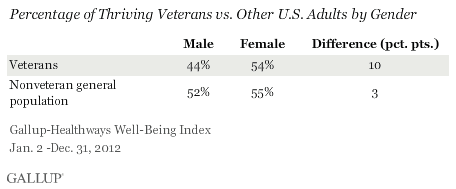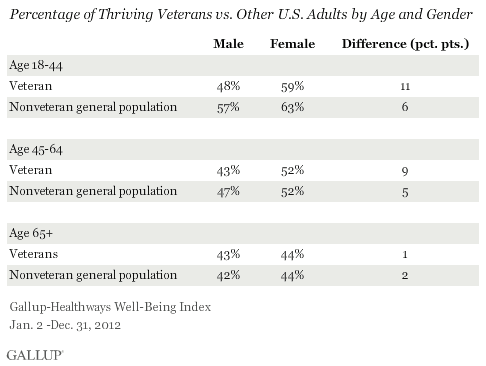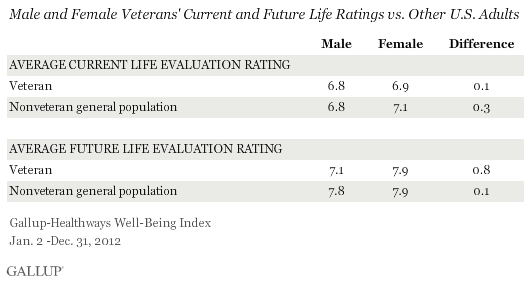WASHINGTON, D.C. -- Female veterans of the U.S. military have a much better outlook on their lives than male veterans do. In 2012, female veterans were far more likely to rate their lives as "thriving" (54%) than their male counterparts (44%). Additionally, while female veterans' life ratings are nearly on par with women in the general U.S. population, male veterans' ratings lag behind other men by a difference of eight percentage points.

These findings are based on data collected as part of the Gallup-Healthways Well-Being Index from Jan. 2 through Dec. 31, 2012, encompassing interviews with 353,561 Americans. Among the general survey population, 48,690 respondents indicated they were a veteran, either retired from service or honorably discharged from the U.S. military.
The relationship between gender and well-being among veterans under the age of 65 is significant, even when controlling for employment status, income, race, education, geographic location, and whether or not one has children.
But, the influence of gender on well-being is absent among veterans aged 65 and older. Male and female veterans aged 65 and older are about equally likely to be thriving -- and they are just as likely to be thriving as their nonveteran counterparts.
This is not the case for younger veterans. In the youngest age group -- those aged 18 to 44 -- female veterans are 11 points more likely than male veterans to be thriving. And, while female veterans are just as likely as nonveterans to be thriving, men are significantly less likely than men in the general population of their same age group to be thriving.
This pattern is similar for those aged 45 to 64, but to a lesser extent.

Gallup classifies Americans as "thriving," "struggling," or "suffering" according to how they rate their current and future lives on a ladder scale with steps numbered from 0 to 10 based on the Cantril Self-Anchoring Striving Scale. People are considered thriving if they rate their current lives a 7 or higher and their lives in five years an 8 or higher. People who rate their current or future lives a 4 or lower are classified as suffering. All others are considered struggling.
Gallup previously found that veterans, in general, lag the general population and their active duty counterparts in how they rate their lives and in other aspects of well-being. These new findings reveal that men struggle more than women after discharge from the military, particularly those in the youngest age group -- at least in terms of how they view their lives.
Personal Optimism Explains Female Veterans' Higher Life Ratings
Female veterans' higher life ratings stem from their greater optimism about their future when compared to their male counterparts.
On average, male veterans rate their future lives a 7.1 out of 10, lower than the 7.8 average for men in the general population. But female veterans rate their lives in the future a 7.9 on average, the same as women in the general population. Both male and female veterans rate their current lives about the same as their counterparts in the general population do on average.

Male veterans' less optimistic outlook may be related to their pessimism about their standard of living. While female veterans and women in the general population are about equally likely to say their standard of living is getting worse, male veterans are 12 points more likely than other men to say the same.

Implications
Growing attention to the unique characteristics of male and female veterans and recent changes to the role women play in the U.S. armed forces has reinvigorated the discussion on gender implications for the military. With the number of veterans continuing to increase after the end of the Iraq War and as U.S. troops continue to leave Afghanistan, the Department of Veterans Affairs and the Department of Defense are paying close attention to the impact of programs supporting the reintegration needs of both genders of veterans. The veteran population they serve is diverse and includes men and women returning from lengthy or multiple deployments, aging veterans, parents who are veterans, and wounded warriors. It is important to better understand what influences the health and well-being of these soldiers once home to ensure that less of them end up struggling or suffering in their lives.
As the number of male and female combat veterans rises, policies reflecting the reintegration needs of soldiers will require further research to meet their well-being needs. And it is possible that policymakers can learn from what drives male and female veterans' life evaluations and apply that to helping veterans improve their well-being.
About the Gallup-Healthways Well-Being Index
The Gallup-Healthways Well-Being Index tracks well-being in the U.S. and provides best-in-class solutions for a healthier world. To learn more, please visit well-beingindex.com.
Survey Methods
Results are based on telephone interviews conducted as part of the Gallup-Healthways Well-Being Index survey Jan. 2-Dec. 31 2012, with a random sample of 353,561 adults, aged 18 and older, living in all 50 U.S. states and the District of Columbia.
For results based on the total sample of national adults, one can say with 95% confidence that the margin of sampling error is ±1 percentage points.
[For results based on the total sample of Veterans, one can say with 95% confidence that the margin of sampling error is ±1 percentage points.]
Interviews are conducted with respondents on landline telephones and cellular phones, with interviews conducted in Spanish for respondents who are primarily Spanish-speaking. Each sample of national adults includes a minimum quota of 50% cell phone respondents and 50% landline respondents, with additional minimum quotas by region. Landline telephone numbers are chosen at random among listed telephone numbers. Cell phones numbers are selected using random digit dial methods. Landline respondents are chosen at random within each household on the basis of which member had the most recent birthday.
Samples are weighted to correct for unequal selection probability, nonresponse, and double coverage of landline and cell users in the two sampling frames. They are also weighted to match the national demographics of gender, age, race, Hispanic ethnicity, education, region, population density, and phone status (cellphone only/landline only/both, cellphone mostly, and having an unlisted landline number). Demographic weighting targets are based on the March 2012 Current Population Survey figures for the aged 18 and older U.S. population. Phone status targets are based on the July-December 2011 National Health Interview Survey. Population density targets are based on the 2010 census. All reported margins of sampling error include the computed design effects for weighting.
In addition to sampling error, question wording and practical difficulties in conducting surveys can introduce error or bias into the findings of public opinion polls.
For more details on Gallup's polling methodology, visit www.gallup.com.
